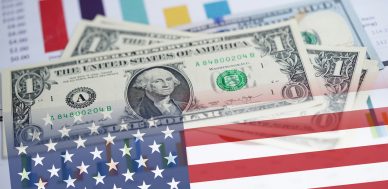Fundamentals of the U.S. Dollar Seem Tormented
The dominance of the U.S. dollar in the world may not remain too long, and it won’t end well for anyone.
Before going into any details, let’s get one thing straight: currencies these days are not backed by gold. We ditched that system a while back. Gone are the days when there was some accountability and money wasn’t created out of thin air.
Now one could ask: “How do you assess a currency?”
Well, you look at the currency’s fundamentals. You look at things like how the government is doing, the country’s debt, and economic performance. You ask if there any other rival currencies, and so on and so forth.
Sadly, when you do the analysis of the U.S. dollar, you quickly find that the fundamentals that could drive the greenback are tormented.
Here’s some perspective.
U.S. Government Is Spending Without Remorse
Budget deficits and the national debt hurt currencies a lot over the long term. If a country is spending without any remorse—reporting massive deficits and borrowing money with two hands—in the long term, it doesn’t end well.
There comes a point when the creditors to the country say, “We want our money back.” And we have seen some recent examples of this happening, countries failing to pay their debt and their currencies falling off a cliff.
Know this: the U.S. government is the most indebted nation in the world. At the time of writing, the U.S. national debt stood at over $23.0 trillion. (Source: “The Daily History of the Debt Results,” Treasury Direct, last accessed November 18, 2019.)
The kicker: if you think that $23.0 trillion is a lot, don’t be shocked if you see it surge to $30.0 trillion within a decade.
The U.S. government is spending immense amounts of money. In its fiscal-year 2019, which ended in September, the U.S. government incurred a budget deficit of almost $1.0 trillion. (Source: “Final Monthly Treasury Statement,” U.S. Department Of The Treasury, last accessed November 18, 2019.)
The last time the budget deficit was this big, the U.S. economy was trying to get out of a severe financial crisis. Right now, the U.S. government is spending like it’s in crisis times, even though everything is actually great. That’s throwing more gas on the fire.
There’s no budget surplus in sight. Now, imagine this: there’s a slowdown in the U.S. economy. What will the U.S. government do? It might be forced to spend a lot more than it already has been doing. So, you could expect the debt to grow much faster.
Here’s something that should bother you: the U.S. national debt doubled in less than a decade. In the third quarter of 2008, the U.S. national debt stood at $10.0 trillion. It reached $20.0 trillion in the third quarter of 2017. (Source: “Federal Debt: Total Public Debt,” Federal Reserve Bank of St. Louis, last accessed November 18, 2019.)
This time around, the debt is on track to double much quicker.
This Won’t End Well
Dear reader, all of this should make you nervous.
Massive deficits and the soaring national debt could be bringing that “We want our money back” moment sooner. This will not be good for the U.S. dollar.
I will end with what I said earlier: the end of the U.S. dollar as the dominant currency could be nearing. If you own a lot of U.S. dollars and U.S. dollar-dominated assets, it may be a time to pause and reflect.
